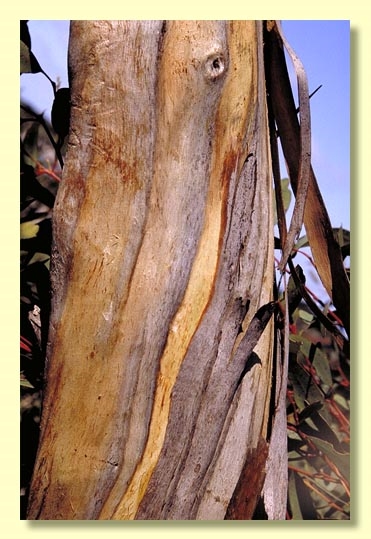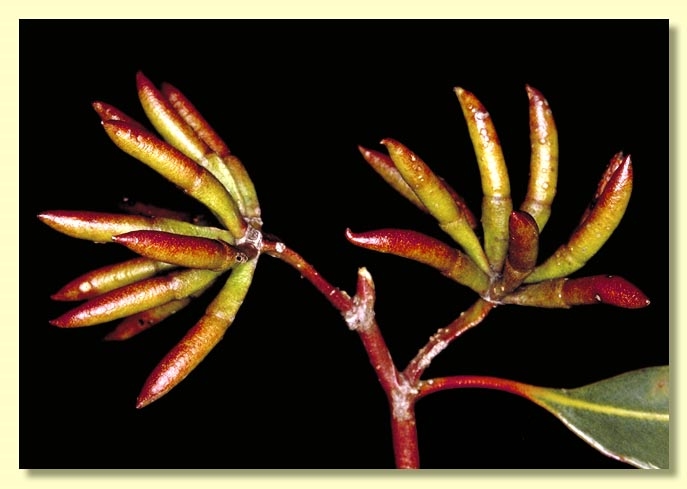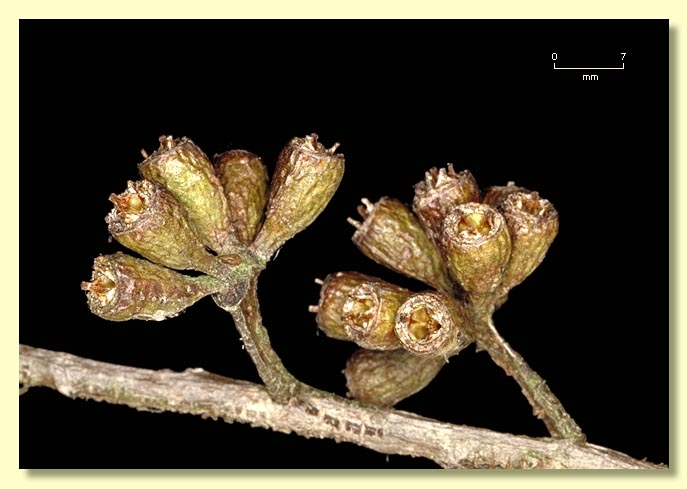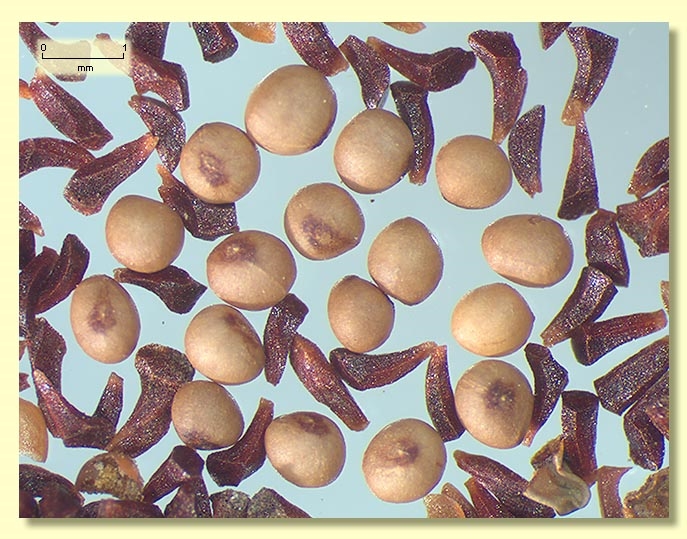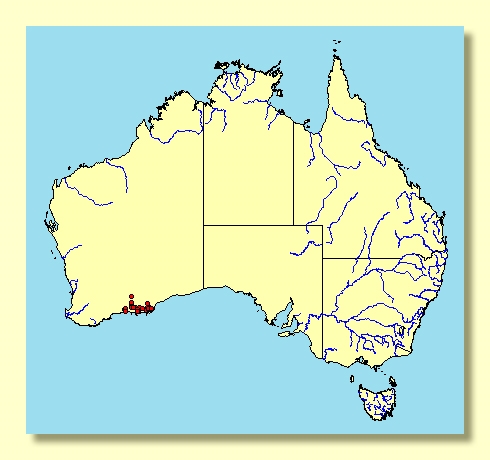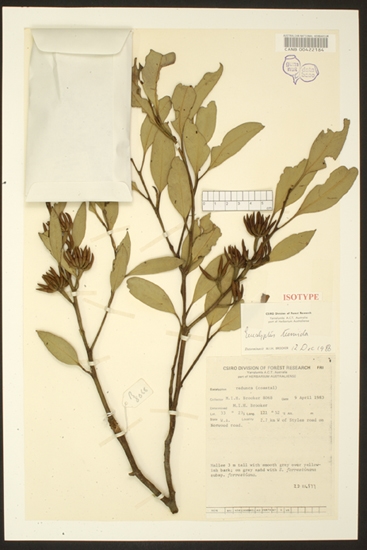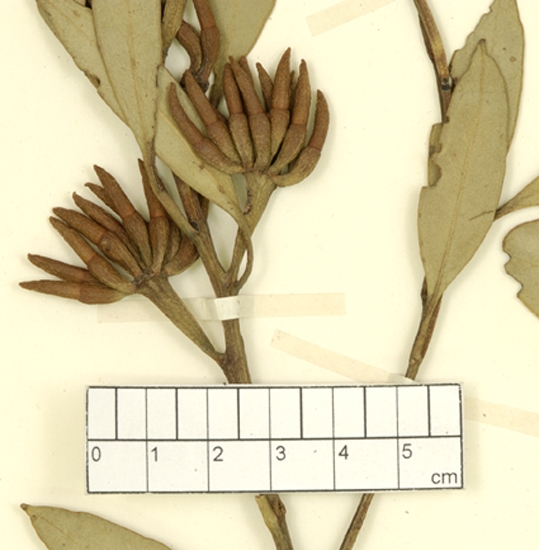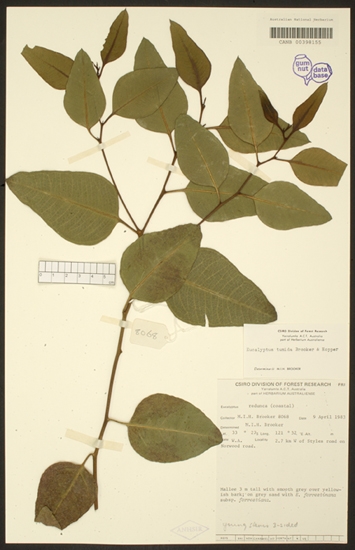Eucalyptus | Symphyomyrtus | Bisectae | Glandulosae | Levispermae | Phaenophylla
Euclid - Online edition
Eucalyptus tumida
Bark smooth throughout, brown and grey over creamy orange to yellowish.
Branchlets have oil glands in the pith.
Juvenile growth (coppice or field seedlings to 50 cm): stems rounded in cross-section; juvenile leaves always petiolate, alternate, ovate, 6–7.5 cm long, 3.3–4.5 cm wide, dull, blue-green.
Adult leaves alternate, petioles 1–2 cm long; blade lanceolate, 6–10 cm long, 1.2–2.5(3) cm wide, base tapering to petiole, margin entire, apex pointed, concolorous, dull to slightly glossy, green, side-veins greater than 45° to midrib, reticulation moderate to dense, intramarginal vein remote from margin, oil glands numerous, island and intersectional.
Inflorescence axillary unbranched, peduncles flattened, widening apically, 1–2 cm long, buds 11 to ?15, pedicellate (pedicels 0.1–0.4 cm long). Mature buds sausage-shaped (1.2–2.2 cm long, 0.3–0.5 cm wide), scar present, operculum horn-shaped, about three times the length of the hypanthium and equal to it in width at the join, few outer stamens erect, most stamens variably deflexed, anthers oblong, versatile, dorsifixed, dehiscing by longitudinal slits, style long and straight, stigma rounded to tapered, locules 3, the placentae each with 4 vertical rows of ovules. Flowers white to pale yellow.
Fruit pedicellate (pedicels 0.1–0.4 cm long), usually cylindrical to elongated obconical, 0.7–1.1 cm long, 0.6–0.7 cm wide, disc descending vertically, valves 3, near rim level.
Seeds straw-coloured, 1–2 mm long, sub-spherical, surface smooth, hilum ventral/terminal.
Cultivated seedlings (measured at ca node 10): cotyledons Y-shaped (bisected); stems rounded in cross-section; leaves always petiolate, opposite for 3 or 4 nodes then alternate, ovate 4.5–9 cm long, 3–4.5 cm wide, dull to slightly glossy, green.
Flowering has been recorded in January, February, September, October, November and December.
A mallee endemic to Western Australia, occurring in sub-coastal areas from east and north-east of Ravensthorpe east towards Israelite Bay and inland as far as Salmon Gums, usually on gravelly soils on low rises, not on coastal sands. The stems are smooth and the adult leaves glossy green.
Eucalyptus tumida belongs to Eucalyptus subgenus Symphyomyrtus section Bisectae subsection Glandulosae because the cotyledons are bisected, buds have an operculum scar and the branchlets have oil glands in the pith. Within this subsection, E. tumida is one of a group of species that form series Levispermae subseries Phaenophylla characterised by having smooth sub-spherical seed, a peduncle that widens apically, buds that are narrowly fusiform with some stamens erect and others variably deflexed, and glossy green leaves.
E. tumida is distinguished from its closest relatives, E. phaenophylla and E. luteola, by having fatter more sausage-shaped buds, not conspicuously tapering to a fine point and by having the operculum equal in width to the hypanthium at the join (not narrower at the join as in E. arachnaea and E. phaenophylla subsp. phaenophylla). The adult and juvenile leaves of E. tumida are also slightly wider than in any of these species. The distributions of E. phaenophylla subsp. interjacens and E. tumida overlap in the area north-east of Ravensthorpe and specimens from this area may be difficult to determine with certainty. Another closely related species the coastal sand-dweller E. varia subsp. varia , has crown leaves that mature glossy green, buds with finely tapering operculum and distinctly yellow flowers.


